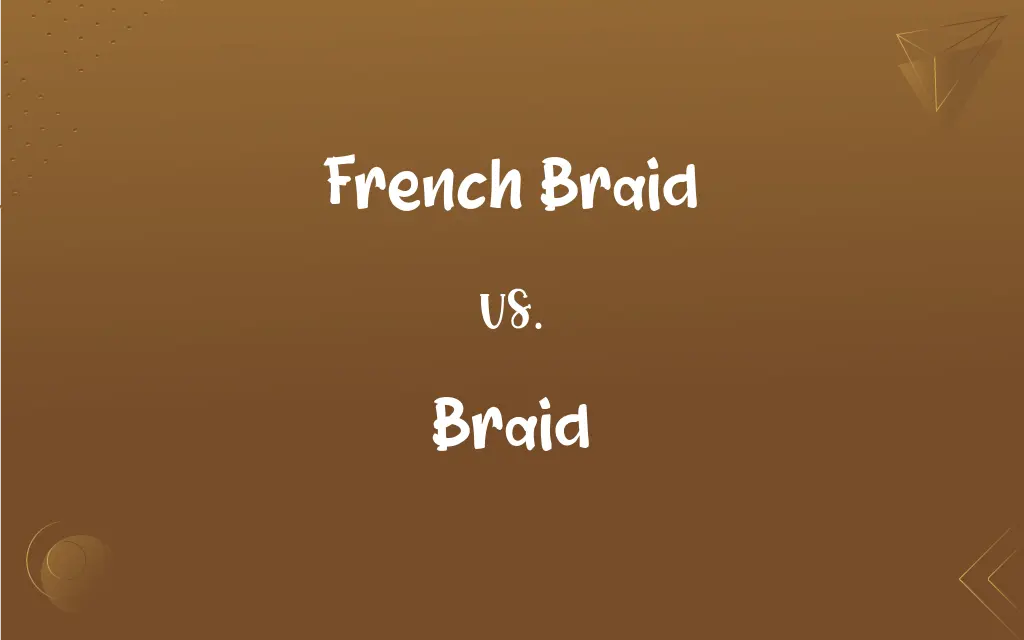French Braid vs. Braid: What's the Difference?
Edited by Janet White || By Harlon Moss || Updated on October 27, 2023
A french braid incorporates new hair sections as it progresses, while a braid divides hair into three strands woven together without adding more hair.

Key Differences
A french braid is a unique hairstyle that begins at the crown of the head and progresses down, while continuously adding new sections of hair to each strand as it's woven. On the other hand, a braid is a simpler hairstyle where hair is divided into three strands and woven together, typically without incorporating additional sections of hair.
The french braid often provides a snug, sleek appearance because it starts close to the scalp and captures loose hair as it moves downwards. In contrast, a braid can start at any point along the hair length and usually does not involve the same tightness or incorporation of loose strands as the french braid.
The appeal of a french braid often lies in its intricate pattern that appears to be embedded into the scalp, presenting an elaborate design. The braid, however, offers a classic and easily recognizable pattern of intertwining strands, which can be executed quickly and without as much skill as the french braid.
While both the french braid and braid can be adorned in various styles, the former often appears as a single central braid running down the back of the head. The latter, the braid, can appear as multiple braids, side braids, or even braided updos, granting it a versatile touch.
Comparison Chart
Starting Point
Begins at the crown of the head.
Can start at any point along the hair length.
ADVERTISEMENT
Incorporation
Adds new sections of hair as it progresses.
Usually does not incorporate additional hair.
Pattern
Appears embedded into the scalp.
Classic intertwining of three strands.
Tightness
Typically snug and sleek.
Can be loose or tight depending on the style.
Versatility
Often a single central braid.
Can be multiple, side braids, or braided updos.
French Braid and Braid Definitions
French Braid
An intricate braid pattern appearing embedded into the scalp.
The french braid she wore to the wedding was a topic of admiration.
ADVERTISEMENT
Braid
An intertwining pattern made of multiple hair sections.
The braid in her hair was adorned with small flowers.
French Braid
A tight and continuous braid that begins near the forehead and continues down the back.
Her french braid gave a sophisticated touch to her casual outfit.
Braid
A versatile hair arrangement that can vary in tightness and location.
For the festival, she wore multiple colorful braids.
French Braid
A snug and sleek braiding technique incorporating all hair.
The athlete chose a french braid to keep her hair out of her face during the match.
Braid
A hairstyle created by interweaving three strands of hair together.
She tied her hair into a simple braid before going for a run.
French Braid
A hairstyle that starts at the crown and involves adding hair sections as it's woven downwards.
She wore her hair in a french braid that trailed elegantly down her back.
Braid
A classic hair design, often used for simplicity and quick styling.
After swimming, she quickly fashioned her wet hair into a braid.
French Braid
A progressive braiding method adding hair from the sides as it descends.
She learned to make a french braid from watching online tutorials.
Braid
A woven pattern, often symbolic of unity and strength.
The storyteller mentioned a heroine with a long, powerful braid.
Braid
To interweave three or more strands, strips, or lengths of in a diagonally overlapping pattern
Braided the rags into a strong rope.
FAQs
What's the main distinction between a french braid and a braid?
A french braid adds new hair sections as it progresses, while a braid involves weaving three strands without adding more hair.
How tight is a typical french braid?
A french braid is usually snug and sleek, capturing hair close to the scalp.
Which is more intricate, a french braid or a braid?
A french braid is often considered more intricate due to its embedded appearance on the scalp.
How long does it take to create a french braid vs. a braid?
While it varies by individual, a braid can usually be done faster than a french braid.
How do you avoid hair breakage with a french braid?
It's crucial to ensure the french braid isn't too tight and to use gentle hair products.
How often should you redo a braid?
Depending on hair type and activity, a braid may need redoing daily or every few days for neatness.
What's the origin of the term "french braid"?
The term's origin is unclear, but the technique predates its popularity in France, being found in ancient art and artifacts worldwide.
Can both hairstyles be adorned with accessories?
Absolutely! Both french braids and braids can be adorned with hair accessories like beads, flowers, or ribbons.
Are braids symbolic in any cultures?
Yes, braids hold symbolic meanings in various cultures, often representing strength, unity, or tradition.
Can a braid be used in other contexts beyond hair?
Yes, the concept of braiding is used in various crafts, including making ropes, jewelry, and textiles.
Is one easier to create than the other?
Generally, a simple braid is easier to create than a french braid, which requires more skill.
Can men wear both french braids and braids?
Yes, both hairstyles can be worn by anyone, regardless of gender.
Are there variations of the french braid?
Yes, there are variations like the Dutch braid or fishtail which are similar but have distinct weaving patterns.
How long should hair be to create a braid?
While longer hair offers more braiding options, even shorter lengths can be braided with skill.
Is it common to see french braids in professional settings?
French braids are versatile and can be appropriate for both casual and professional settings.
Which style is more protective for hair health?
Both can be protective styles, but the snug nature of a french braid may offer more protection from environmental elements.
Can you exercise with a french braid?
Yes, a french braid can be an excellent style for exercise, keeping hair secure and away from the face.
Can you start a braid from the crown like a french braid?
While a french braid typically starts from the crown, a braid can start from any point on the hair.
Is a braid a versatile hairstyle?
Yes, a braid can be fashioned in multiple ways, such as side braids or braided updos.
How do you maintain a french braid overnight?
Wearing a silk or satin scarf can help maintain a french braid overnight.
About Author
Written by
Harlon MossHarlon is a seasoned quality moderator and accomplished content writer for Difference Wiki. An alumnus of the prestigious University of California, he earned his degree in Computer Science. Leveraging his academic background, Harlon brings a meticulous and informed perspective to his work, ensuring content accuracy and excellence.
Edited by
Janet WhiteJanet White has been an esteemed writer and blogger for Difference Wiki. Holding a Master's degree in Science and Medical Journalism from the prestigious Boston University, she has consistently demonstrated her expertise and passion for her field. When she's not immersed in her work, Janet relishes her time exercising, delving into a good book, and cherishing moments with friends and family.
































































